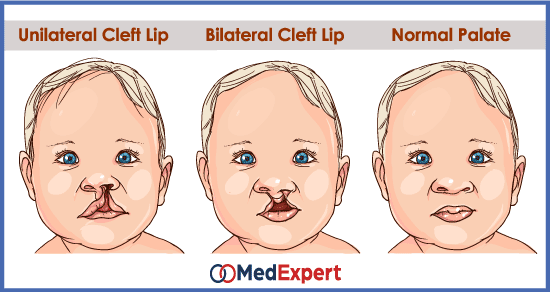CLEFT LIP AND CLEFT PALATE
Cleft lip and cleft palate are facial and oral malformations develop while the baby is developing inside the mother. Clefting occurs when there is insufficient tissue in the mouth or lip area, and when this tissue does not properly join together.

A cleft lip is a physical split or separation of the two sides of the upper lip.. This causes a seperation that extends beyond the base of the nose and includes the bones of the upper jaw and/or upper gum.
A cleft palate is a split or opening in the roof of the mouth that often involves the bony front portion of the roof of the mouth (hard palate), and/or the soft back portion of the roof of the mouth (soft palate).
One or both sides of the mouth can be affected by cleft lip and cleft palate. It is possible to have a cleft lip without a cleft palate, a cleft palate without a cleft lip, or both together, because the lip and palate develop independently of each other.
SIGNS AND SYMPTOMS OF CLEFT LIP CLEFT PALATE
- Cleft lip: A cleft lip is characterized by a physical split or separation of the two sides of the upper lip. This appears as a narrow opening or gap in the skin of the upper lip.
- Cleft palate: A cleft palate is characterized by a split or opening in the roof of the mouth
TREATMENT OPTIONS AVAILABLE FOR CLEFT LIP & CLEFT PALATE
Cleft Lip Repair, Gingivoperiosteoplasty (GPP) And Primary Rhinoplasty
This procedure is done alongside Naso Alveolar Molding (NAM). NAM involves narrowing the cleft of the lip and the alveolus (gum bone) by having the cleft baby wear a device from as early as possible after birth.
The nasal deformity associated with the cleft lip can also be improved using this method. By reducing the severity of all three aspects of the cleft, it then becomes possible to surgically repair the cleft lip, cleft alveolus (gingivoperiosteoplasty, or GPP), and cleft lip nasal deformity (primary rhinoplasty) in a single operation.
Doing it this way can potentially save the patient from two operations later in life, as alveolar bone grafting and a secondary cleft rhinoplasty may not be required later . The repair is usually performed when the baby is 3 months old.
Cleft Palate Repair
Cleft palate repair consists of 2 primary goals: repairing the physical cleft so that any food and liquids will not spill into the nose from the mouth, and to realign the muscles of the soft palate to improve speech ability.
Speech Surgery following Cleft Palate Repair
Further surgical procedures may be necessary later in childhood If the child has speech problems despite an adequate cleft palate repair. These involves using tissues taken from behind the tonsils to make it easier for the soft palate muscles to work effectively during speech.

Alveolar Bone Grafting
In order to support the tooth that erupts in that location, the cleft in the alveolus (gum bone) must be repaired. If it a GPP was not done during infancy, this repair is carried out between the ages of 8 and 10. This is around the age just before the permanent teeth begin to erupt. Bone graft used to repair the alveolar cleft is harvested from the hip.
Cleft Orthoganthic Surgery
Cleft lip and palate are often associated with insufficient growth of the upper jaw and usually results in an abnormal bite and appearance. Sufficient growth of the upper jaw can be stimulated by using non=surgical orthodontic techniques, otherwise, orthognathic (jaw) surgery involving the upper jaw, lower jaw or both may be required. In order to achieve correct positioning of the jaws and teeth orthognathic surgery must be performed alongside orthodontic treatment (wearing braces). It is usually carried out when the patient is a teenager.
Secondary Cleft Rhinoplasty
If a significant nasal deformity associated with the cleft later remains later in life, a secondary cleft rhinoplasty can be performed to improve the appearance of the nose and usually takes place when the patient is a teenager and after the jaw surgery, if that was required.
DIAGNOSING CLEFT LIP & CLEFT PALATE
- History taking: A cleft lip or cleft palate is easy to diagnose because they cause very obvious physical changes. Prenatal ultrasound can sometimes detect if a cleft exists in an unborn child. If the clefting has not been detected in an ultrasound prior to the baby’s birth, a physical exam of the mouth, nose, and palate confirms the presence of cleft lip or cleft palate once the child has been born. The presence of other abnormalities can be ruled out using other diagnostic testing methods.


